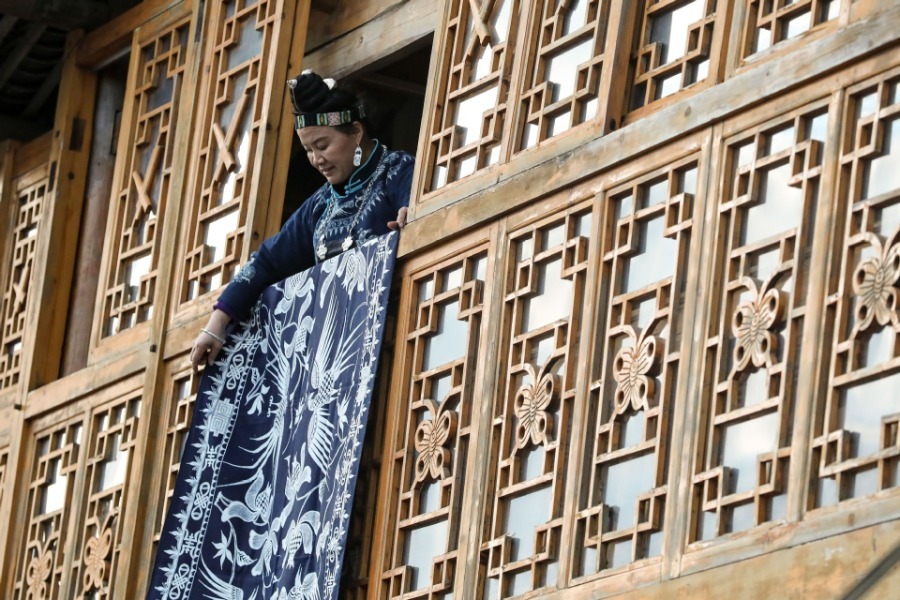(ANN/CHINA DAILY) – In a serene neighbourhood in Danzhai county, Guizhou province, a striking four-story building comes to life after sunset. Illuminated within, a group of local Miao women diligently practice the art of Miao batik.
This building is home to the Ninghang Batik Co, honored as a national model site for the preservation of production-based intangible cultural heritage in 2014.
Miao batik is just one of eight national intangible cultural heritage items cherished in Danzhai. Recognized as a national heritage in 2006, this craft is faithfully preserved in its traditional form within the county.

Using beeswax and indigo grass as their materials, these female artists, known as “painting ladies,” skillfully utilise wax as ink, knives as pens, and cloth as paper to vividly illustrate the beautiful imagery from their minds.
Over the past decade, company founder Ning Manli has led Miao women to bring vitality to the once-niche ethnic craft by introducing it to a broader market.
Originally from Anhui province, Ning came across the craft during her travel to Kaili city, the capital of Qiandongnan Miao and Dong autonomous prefecture where Danzhai is located, about 14 years ago.
“I watched a folk handicraft competition and was immediately drawn to batik,” Ning said.
As she was engaged in a business producing clothing materials, Ning realised that her fabrics could be used for batik in Guizhou.
She set her sights on Paimo village in Danzhai after tracing the origins of the craft.

To her surprise, most people there were no longer engaged in batik making, telling Ning that machine-dyed fabrics could be easily obtained from the downtown area of the county.
Realising the potential and value of the intangible cultural heritage, Ning persuaded the local women to revive the craft that they had practiced since childhood and have it commercialised through production.
At first, only a few women accepted her offer, but as they began earning money for their work, many more joined Ning’s cause.
Since then, Ning and her batik ladies have committed themselves to Miao batik garment design, production, processing and sales.
In 2014, the Ninghang Batik Co was named a demonstration site for production-based intangible cultural heritage protection.
It has encouraged Ning to keep integrating traditional craft with modern fashion, giving rise to a series of batik linen bedding, curtains, scarves, qipao (a traditional Chinese dress), handkerchiefs and bags.
“We have been sticking to the traditional methods and applying them to functional application and design,” Ning said.

In 2020, Ning led her team to deliver 36 batik costumes that were featured during London Fashion Week.
In 2021, her team crafted a 100-meter batik scroll featuring hundreds of birds that was dedicated to the centenary of the founding of the Communist Party of China and is now part of the permanent collection of the National Museum of China.
To date, Ning’s operations have delivered more than 40 products of innovative styles every year and can produce 4,000 items a month.
The production of Miao batik has improved the lives of local women and has better promoted the traditional craft. Annual sales have been as high as CNY8 million (USD1.1 million), Ning said.
Yang Naijin, a villager from Danzhai, used to struggle to earn a living doing odd jobs, earning only CNY30 a month.
Since she joined Ning’s team, she has made use of her batik-making abilities and her income has significantly increased. As her skills and artistic taste improved, Yang became a guest lecturer at local vocational schools.
“It’s batik that has given me a sense of dignity as a Miao woman,” Yang said.
Over the years, Ning’s company has also opened training classes for inheritors of intangible cultural heritage and has made inroads in more than 40 institutes of higher learning across the country to give young people the opportunity to study Miao batik.
To date, more than 200 Miao women from surrounding villages have benefited from the growing batik industry.
In March, Ning’s business was again named a national model for production-based intangible cultural heritage protection by the Ministry of Culture and Tourism.
“I feel particularly honored, and I hope that in the future, the government will provide us with more policy support, so we can keep concentrating our efforts to promote Miao batik,” Ning said.






